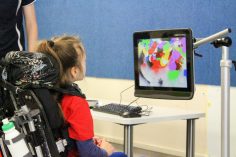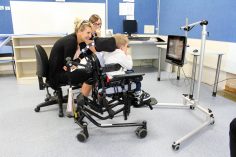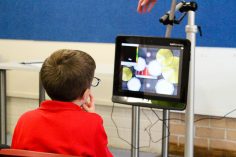Eye gaze trial supports students to reach their potential
28 November 2018

Led by the Independent Living Centre WA, a pilot project that trialled eye gaze technology in schools has shown how this technology can support students with complex physical needs to learn, communicate and participate in recreation activities.
The Engaging in Eye Gaze project has led to increased awareness amongst schools about how eye gaze technology can help to maximize students’ educational outcomes.
In addition, the project has increased access to this technology in schools through the development of a range of free resources including videos and information sheets to support the use of eye gaze technology.
Eye gaze technology allows the user to control a computer or communication device by using the movements of their eyes.
The technology has the potential to benefit a range of people including students with complex physical needs who have difficulty pointing to or manipulating recreation, communication or learning materials.

Within the classroom, eye gaze technology has the potential to increase students’ participation in classroom activities, with examples including turning the pages and engaging with books, completing a painting with their eyes, engaging in play and recreation such as music or games, as well as giving access to vocabulary for communication.
Led by Independent Living Centre WA Speech Pathologist Tanith Brien and Occupational Therapist Jen Blaxill, the project involved around 50 students from nine West Australian schools.
A range of clinics were provided onsite at schools to enable students who may benefit from its use to trial eye gaze technology. Support and training was also provided to schools who either own or hired eye gaze systems.
Ms Brien said that while eye gaze technology itself isn’t new, it is becoming more accessible and the trial within schools demonstrated its potential for supporting students in a range of ways as well as assisting teachers to assess students.
“All students have a right to access to, and participate in, education.
“This trial demonstrated that eye gaze technology can support lots of different kids in a range of ways.
“For example, as well as supporting kids to communicate and learn, the technology is a great tool for helping kids to develop skills for play,” said Ms Brien.
“This technology can also assist teachers to assess a student’s knowledge and understanding when other methods such as writing, pointing or speaking an answer are difficult.”

The long-term potential of this technology could include students progressing to using eye gaze for full computer access including browsing the internet, using word processing, or controlling their environment such as automated blinds, lighting and TV remotes.
As part of the project a video series and information sheets have been produced to support the successful use of eye gaze technology in the classroom.
A range of eye gaze technology options are available for hire through Indigo Hire.
The pilot project was funded through a grant from the Non-Government Centre Support for Non-School Organisations.
Indigo speech pathologists and occupational therapists worked with the latest assistive technology and communication aids to help students participate, learn and communicate in schools.

 Translate
Translate